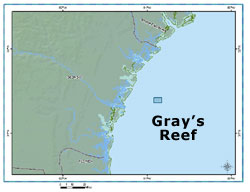|
 Right Whale Swims Free Right Whale Swims Free
In December 2004, sanctuary staff responded to a call for support by NOAA Fisheries scientists to disentangle an endangered juvenile right whale. The whale had first been sited entangled and trailing a marker buoy three weeks earlier. The sanctuary provided two vessels to serve as the platforms from which the disentanglement efforts took place. The animal was successfully freed about two weeks later.
North Atlantic right whales are the most endangered great whale in the world, and a major reason for injury or death is entanglement in abandoned fishing gear or other marine debris. These whales migrate 2,000 miles each fall from their feeding grounds off the coasts of the northeastern U.S. and Canada to birth their calves in the warm shallow waters off the southeast U.S. coast. Due to their tendency to swim at the surface in coastal waters, right whales are at a higher risk due to entanglement or vessel strikes.
Sanctuary staff works with NOAA and other partners along the entire east coast to respond to whale emergencies and to educate fishermen, boaters and the maritime shipping industry on how to avoid harming this magnificent animal.
Sanctuary Begins Getting Routine Health Check-Ups
A monitoring program was established at Gray's Reef that will provide some of the first long-term water quality observations available in sanctuary waters. Every 4-to-6 weeks since February 2005, water samples at various depths are taken in the sanctuary to measure a variety of ocean health indicators.
Initial analyses of nutrients, dissolved oxygen and chlorophyll-a concentrations suggest the sanctuary waters are not being impacted by human activities unlike many near shore areas along the Georgia coast. This is good news for the fish, turtles and other marine life that call Gray’s Reef home. Scientists will closely monitor water quality for any changes so we can respond quickly to any threats to the sanctuary.
Distance Learning: Bringing Gray’s Reef to the Midwest
A teacher in central Nebraska can now bring her students to the ocean as a result of distance learning technology being used by sanctuary educators. Through the magic of specialized television hook-ups, Gray’s Reef staff can talk to students anywhere satellite broadcasts can be received. The site held 14 “distance learning” broadcasts in 2005. The sanctuary program is planning to use this technology at other sanctuaries in our efforts to enhance public awareness and appreciation of the marine environment for all Americans. Exclusive Stories for the Web
Scientists Learning About Important Gray’s Reef Animals
Scientists are learning valuable information on how the corals, sponges and other invertebrates reproduce, find places to live and grow on the sanctuary’s rocky limestone ledges. Preliminary genetic investigations indicate that sanctuary populations of temperate hard corals are maintained by local recruitment of asexually and sexually produced offspring. Larval invertebrates also drift into the sanctuary on ocean currents then metamorphose into a form that allows them to settle on the bottom and grow into adult forms. Knowing how the invertebrate community of the sanctuary is structured will help scientist better understand how it grows and changes overtime. It will also help us know what to expect in terms of re-growth should the community ever be severely damaged by natural events such as storms or some manmade catastrophe.
Acoustic System Tested
Gray’s Reef National Marine Sanctuary researchers have been listening to the under water sounds of the sanctuary to expand the methods of monitoring fish populations. In 2005, the staff deployed an autonomous underwater listening system several times to record the ambient underwater sounds of the sanctuary. The sound captured by the system will eventually be made available to the public via the sanctuary’s website.
Passive and active hydro-acoustics were also used as part of an overall method for monitoring fish populations. Passive acoustic systems simply listen and record, i.e. instruments in the water that detect sounds. The data is then downloaded and/or analyzed. Think of the submarine sonar operator listening for propellers or other noises. Active acoustic systems send out noise signals in one form or another. The sound can bounce off something and be detected back at the same source or produce a sound so a receiver or receivers can track it. For example, transponders implanted in fish are tracked by receivers placed in known positions.
The NOAA National Centers for Coastal Ocean Sciences lab in Charleston, S.C., deployed active acoustics in attempts to estimate pelagic fish biomass and to identify locations and sizes of spawning groups. In addition, scientists from NASA deployed an experimental passive acoustic monitoring system to characterize the sounds produced by soniferous (sound-producing) fishes to try to pinpoint the locations of spawning aggregations. It’s too soon to look for results from these cutting-edge methods, but they should yield information for resource management in the future.
Plans for 2006
 The site will hold its third Ocean Film Festival in September 2006. This festival brings the message of ocean stewardship to community members who may not have the opportunity to explore the sanctuary first hand. The sanctuary will continue to deploy its autonomous underwater listening system to capture the underwater sounds of the sanctuary. Scientists will use the data to study different inhabitants of the reef in the same way songs of birds are used to track their abundance and movement. The sounds captured by the listening system will eventually be made available to the public. The site will hold its third Ocean Film Festival in September 2006. This festival brings the message of ocean stewardship to community members who may not have the opportunity to explore the sanctuary first hand. The sanctuary will continue to deploy its autonomous underwater listening system to capture the underwater sounds of the sanctuary. Scientists will use the data to study different inhabitants of the reef in the same way songs of birds are used to track their abundance and movement. The sounds captured by the listening system will eventually be made available to the public.
|



